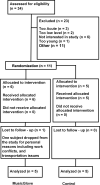Feasibility of home hand rehabilitation using musicglove after chronic spinal cord injury
- PMID: 36347833
- PMCID: PMC9643482
- DOI: 10.1038/s41394-022-00552-4
Feasibility of home hand rehabilitation using musicglove after chronic spinal cord injury
Abstract
Study design: Randomized, controlled single-blind cross over study. This study was registered on ClinicalTrials.gov (NCT02473614).
Objectives: Examine usership patterns and feasibility of MusicGlove for at home hand rehabilitation therapy following chronic spinal cord injury.
Setting: Homes of participants.
Methods: Ten participants with chronic spinal cord injury completed two baseline assessments of hand function. After a stable baseline was determined all participants were randomized into two groups: Experimental and Control. Each group was given a recommended therapy dosage. Following this participants switched interventions.
Results: On average participants had higher levels of compliance (6.1 ± 3.5 h.), and completed more grips (15,760 ± 9,590 grips) compared to participants in previous stroke studies using the same device. Participants modulated game parameters in a manner consistent with optimal challenge principles from motor learning theory. Participants in the experimental group increased their prehension ability (1 ± 1.4 MusicGlove, 0.2 ± 0.5 Control) and performance (1.4 ± 2.2 MusicGlove, 0.4 ± 0.55 Control) on the Graded and Redefined Assessment of Strength, Sensibility, and Prehension subtests. Increases in performance on the Box and Blocks Test also favored the experimental group compared to the conventional group at the end of therapy (4.2 ± 5.9, -1.0 ± 3.4 respectively).
Conclusions: MusicGlove is a feasible option for hand therapy in the home-setting for individuals with chronic SCI. Participants completed nearly twice as many gripping movements compared to individuals from the sub-acute and chronic stroke populations, and a number far greater than the number of movements typically achieved during traditional rehabilitation.
© 2022. The Author(s).
Conflict of interest statement
DJR has a financial interest in Hocoma A.G. and Flint Rehabilitation Devices LLC, companies that develop and sell rehabilitation devices. Flint sells the MusicGlove device examined in this study. The terms of these arrangements have been reviewed and approved by the University of California, Irvine, in accordance with its conflict of interest policies.
Figures





Similar articles
-
Home-based hand rehabilitation after chronic stroke: Randomized, controlled single-blind trial comparing the MusicGlove with a conventional exercise program.J Rehabil Res Dev. 2016;53(4):457-72. doi: 10.1682/JRRD.2015.04.0057. J Rehabil Res Dev. 2016. PMID: 27532880 Clinical Trial.
-
Retraining and assessing hand movement after stroke using the MusicGlove: comparison with conventional hand therapy and isometric grip training.J Neuroeng Rehabil. 2014 Apr 30;11:76. doi: 10.1186/1743-0003-11-76. J Neuroeng Rehabil. 2014. PMID: 24885076 Free PMC article. Clinical Trial.
-
Feasibility of Wearable Sensing for In-Home Finger Rehabilitation Early After Stroke.IEEE Trans Neural Syst Rehabil Eng. 2020 Jun;28(6):1363-1372. doi: 10.1109/TNSRE.2020.2988177. Epub 2020 Apr 15. IEEE Trans Neural Syst Rehabil Eng. 2020. PMID: 32305930 Free PMC article.
-
Clinical Practice Guideline to Improve Locomotor Function Following Chronic Stroke, Incomplete Spinal Cord Injury, and Brain Injury.J Neurol Phys Ther. 2020 Jan;44(1):49-100. doi: 10.1097/NPT.0000000000000303. J Neurol Phys Ther. 2020. PMID: 31834165 Review.
-
Could motor imagery be effective in upper limb rehabilitation of individuals with spinal cord injury? A case study.Spinal Cord. 2012 Oct;50(10):766-71. doi: 10.1038/sc.2012.41. Epub 2012 Apr 17. Spinal Cord. 2012. PMID: 22508537 Review.
Cited by
-
Integration of music-based game approaches with wearable devices for hand neurorehabilitation: a narrative review.J Neuroeng Rehabil. 2024 May 29;21(1):89. doi: 10.1186/s12984-024-01379-w. J Neuroeng Rehabil. 2024. PMID: 38811987 Free PMC article. Review.
-
Commercial exergames for rehabilitation of physical health and quality of life: a systematic review of randomized controlled trials with adults in unsupervised home environments.Front Psychol. 2023 Jun 2;14:1155569. doi: 10.3389/fpsyg.2023.1155569. eCollection 2023. Front Psychol. 2023. PMID: 37333591 Free PMC article.
References
-
- Radomski MV. More than good intentions: Advancing adherence to therapy recommendations. The American journal of occupational therapy: official publication of the American Occupational Therapy Association. 2011;65:471–7. - PubMed
-
- Zondervan DK, Friedman N, Chang E, Zhao X, Augsburger R, Reinkensmeyer DJ, et al. Home-based hand rehabilitation after chronic stroke: Randomized, controlled single-blind trial comparing the MusicGlove with a conventional exercise program. J Rehabil Res Dev. 2016;53:457–72. doi: 10.1682/JRRD.2015.04.0057. - DOI - PubMed

